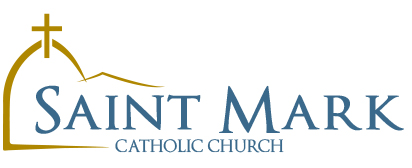History of Shrine
In 1975, a post-Vatican II renovation of St. Mark Church was completed in which the marble side altars and communion rail were removed and the main altar and tabernacle were moved to the side. Earlier depictions of the evangelists and the words and symbols of the Eucharistic sacrifice in colors complementary to the stained glass windows were painted over in favor of a simpler style in earth tones that directed attention to a larger carpeted worship space and wooden altar positioned closer to the pews.
After some 25 years, in the late 1990s discussions began about renovating the church in a manner that not only restored some of its earlier features but satisfied the emphasis in Pope John Paul II’s new evangelization. An initial design by noted Church architect Steven Schloeder in 2000 proved too ambitious and costly but nevertheless prompted much discussion and interest when presented to the parish and Diocesan Architectural Committee in 2000. During that time, however, teaching and spiritual guidance by our Pastor Father Benjamin Reese, based on a careful and prayerful study of Vatican II documents, increased parish understanding of the liturgical importance of both a communion of persons and a communion with our Lord in the Holy Eucharist. These would be simultaneously accommodated by retaining a sanctuary and altar of sacrifice facing and open to the faithful but giving the tabernacle pride of place in the center.
Our Associate Pastor at the time, Father Francis Gallagher, used his prior degree in architecture and appreciation of religious art, to help us see how our renovation could work again with the traditional design features of our church and colors in our stained glass windows. The goal: focus on a matching marble altar of sacrifice which he designed, along with the uncarpeted and restored terrazzo flooring in both the sanctuary and in the body of the church; and at the same time, lift the eyes and hearts of the faithful to God in His heavens through colorful decoration of the pillars, arches, and vaults or our Gothic design.
The restoration component of the project received providential support when Mr. Richard LaHood, who had purchased and stored much of the original marble from the side altars and communion rails, offered the materials back to St. Mark at no charge. Initial financial support came from the estate of Irene Manning, a parishioner who made a bequest for a Marian Shrine that included funds for the movement of the main altar to its original position – and after the Marian and St. Joseph altars were rediscovered and returned at well below cost. With an offer to move and reconstruct our main altar and the rediscovered and returned Marian and St. Joseph altars at well below cost, the project was off and running. Beginning the the spring and summer of 2002, countless hours by numerous men and women, teens, and children of the parish were donated as the worship space structure and carpeting were removed, walls were cleaned and primed for painting, and pews were removed and later reinstalled.
What remained to be decided was the type of art that would grace our Church and the artists willing and able to render it in a meaningful and beautiful manner – within our budget. The answers to both came from very near and very far after much prayer. At about that time, during a visit to Rome, Father Reese was offering Mass for the intention of our parish and Church renovation at St. Catherine of Siena Church (above Minerva) in Rome on an altar over the tomb of Blessed Fra Angelico, Patron of the Arts. His art, its themes and colors proved to be just the right match for our plans.
Closer to home, a parishioner had seen a landscape mural in a local Lebanese restaurant and suggested the artists for that project, Murals by Jericho, might be appropriate for the St. Mark renovation. Artists Andrew Hatermann and Robert and Greta Hill began with the reproduction of Fra Angelico’s Christ in Glory, which depicts the Last Judgment, high above the main altar. Then they painted the beautiful ceiling with some 5,000 gold foil stars. The Coronation of the Queen was next painted above the marble statue of Our Lady holding the baby Jesus on the Marian altar, now the Marian Shrine. From there, the project unfolded and the financial support came forward in a way that the artists, pastor and parish Finance Committee, and parishioners still marvel at as a miracle of God’s grace.
The Church was rededicated by The Most Reverend Daniel R. Jenky, C.S.C., Bishop of Peoria, on the Feast of Christ the King, November 22, 2002. Following completion of the art work above and around the St. Joseph altar, St. Mark Church was designated a Shrine to Blessed Fra Angelico by Bishop Jenky on the Feast of St. Joseph, March 19, 2004.
Work continued with the addition of reproductions of Blessed Fra Angelico’s paintings of the four evangelists in August, 2004.



